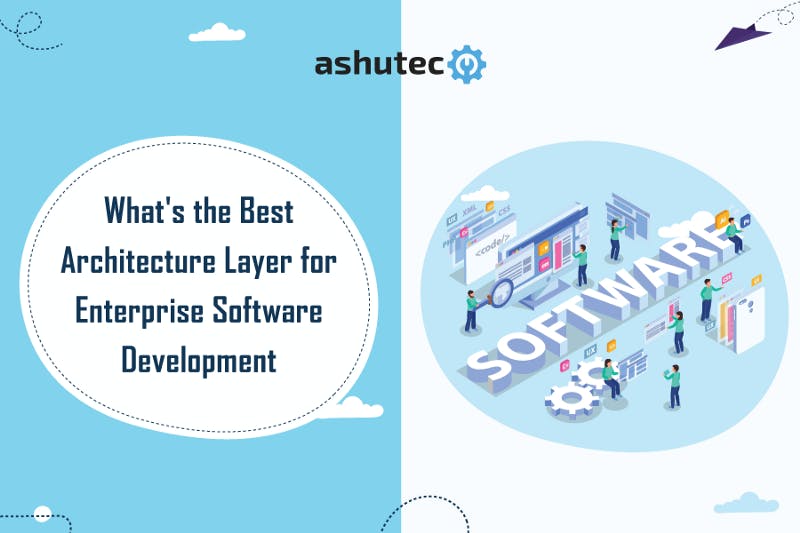Let’s Connect!
Work can be a fun when we know and understand each other well. Let's start conversation to new beginning
+91 63542 35108
To discuss what we can do for you Give us a Call
connect@ashutec.com
Tell us about your next project Write to us

A healthy mind is necessary for the development of a healthy body. Similarly, software architecture builds a foundation for enterprise application development. Think of it as a blueprint of your enterprise app that you must design to build different layers of your app so that end-users can interact with it effortlessly.
There exist different architectural patterns that define the root characteristics for your enterprise app to behave accordingly. It aids in simplifying the internal processes for each component or module and helps determine the building blocks of your applications. The motive behind using an architectural pattern is to make your enterprise software modular, scalable, and maintainable.
Since there are multiple architectural patterns and each has been built for performing different functions, choosing the best one sometimes is difficult. Here, I am presenting different architectural patterns to help you understand and select the best one for your enterprise software development.
It is an architectural style that helps structure an application to make them a collection of services. These services are highly maintainable and testable, loosely coupled, independently deployable, owned by a small team, and organized around business capabilities.
The architecture is ideal for software applications that require deploying different services without making the system overload and can be scaled and maintained effortlessly. Another benefit of this architecture is that it allows enterprises to extend their technology stack.
Further, based on the scope of work, new services can be added as and when needed. The biggest advantage for enterprises is it prevents the whole software from collapsing if some microservices fail or crash. However, there are some challenges such as structuring the right level of microservice, coding in multiple languages, and many others.
The architecture is designed specifically for enterprise software development and works well with distributed systems worldwide.
Also known by many names such as multilayered, N-tier, Multi-Tiered, onion architecture, this pattern is an industry-proven architectural pattern for enterprise-grade software development. Layered architecture pattern has four different levels namely: presentation, business logic, persistence, and database.
This conventional pattern is used by most startups and enterprise businesses to build scalable, reusable, maintainable, secure, and fault-tolerant applications. Thanks to the different layers of the architectural pattern, teams can work independently on each layer. Also, the changes in one layer do not affect the other, making the refactoring process seamless.
However, the management costs are higher, and adding new layers slows down the performance. Still, it’s one of the best architectural patterns for enterprise applications that want to develop software rapidly.
Another great software architectural pattern that supports event producer and event consumer, which are two parts of the working equation. This type of architecture promotes event-driven patterns such as production, detection, consumption, and reaction.
Unlike the layered architecture, the event-driven architecture supports the activated modules for an event when it happens. These events are defined as the change of state and are highly adaptive to the real-time changes. This is best, especially for asynchronous software types with the asymmetric flow of data.
Another great thing about this architecture pattern is it’s made of loose coupling and offers wonderful operation efficiency because of the single-purpose event processing components. This pattern is highly suitable for IoT applications development. However, error handling is not that great and has a complicated data structure for systemwide development.
Still, it is the best software architecture for enterprises that need to access data in real-time through individual data blocks.
It is designed to help overcome the high load issue by breaking and splitting the processing and storage into several servers. The architecture consists of two components: a processing unit and virtualized middleware. Components that are web-based and contain backend business logic are contained by the processing unit. Elements responsible for synchronization and request handling are included in the virtualized middleware.
This type of architecture is commonly utilized for developing bidding auction sites. The biggest benefit of this architecture pattern is it addresses the concurrency and scalability issue. Also, it is beneficial for low-value data. However, it can be a challenge to test the whole system by generating enough load but it can be easy on an individual level.
Same as the Space-based architecture, microkernel architecture has two components called plugin modules and core systems. It is a natural and best-suited architectural approach for developing product-based software applications.
Applications based on this type of architectural pattern only have the required functionality that helps the system to be operational. The addition of extra features is carried out by adding new plugins to the core app, which is why it is also known as the plugin architecture model.
The benefits of this type of architectural pattern include greater flexibility and extensibility to avoid potential downtime. Also, new plugins can be added while the application is in a running state. The downside of this architecture is that it is not highly scalable, and the architecture is dependent on too many plugins, making it difficult to execute the architecture.
In general terms, this architectural pattern is good for developing workflow, job scheduling, tasks, and web browser software applications.
In a nutshell, these were some of the best architectural patterns well suited for enterprise software development. We have seen what each offers, what are their strengths, and their weaknesses as well. Knowing all these things will help you select the right architectural pattern that lives up to your business-specific goals and objectives.
It goes without saying that your architectural decisions must be based on your technological and operational requirements. Also, you must understand how each will impact the system’s functionality.

